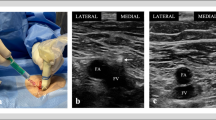Abstract
Purpose
Interventional cardiac electrophysiology (EP) has experienced a significant growth in Canada. Our aim is to establish a periodic registry as a nationwide initiative.
Methods
The registry is designed to collect information regarding EP laboratory infrastructure, human resources, and the spectrum and volumes of EP procedures. Respective administrative staff were contacted electronically.
Results
Out of 25 identified Canadian EP centers, 19 centers (76 %) have participated in the registry. Responding centers have access on average to 5.3 lab days per week to perform EP studies/ablations; average lab time per full- and part-time (prorated to 0.5) EP physician is 0.8 day per week. Diagnostic EP studies and radio-frequency ablations are performed in all (19) centers; cryoablation is available in 83 % of centers. Two centers have remote magnetic navigation systems. EnSite NavX is the most widely available 3D mapping system utilized in 15 (83 %) centers, followed by CARTO and intracardiac echo which are each available in 14 (78 %) centers; LocaLisa is actively used in one center. The number of full-time physicians ranges between 0 and 7, with a mean of 3.5 full-time physicians per center. The ratio of staff to trainees is 1.6:1. A total of 8,041 EP procedures are performed in the 19 centers per annum. On an annual average, 104 procedures per one operator and 159 procedures per trainee are performed.
Conclusions
This registry provides contemporary information on invasive EP lab resources and procedures in Canada. It also demonstrates that Canadian EP procedural intensities of practice and training are comparable to international standards.



Similar content being viewed by others
References
Statistics Canada (2011). Appendix 1 health regions in Canada. http://www.statcan.gc.ca/pub/82-402-x/2011001/app-ann/app1-ann1-eng.htm. Accessed 15 Apr 2013.
Laish-Farkash, A., Shurrab, M., Singh, S., Tiong, I., Verma, A., Amit, G., et al. (2012). Approaches to empiric ablation of slow pathway: results from the Canadian EP web survey. Journal of Interventional Cardiac Electrophysiology, 35, 183–187.
Deering, T., Clair, W., Delaughter, C., Fisher, W., Garlitski, A., Wilkoff, B., et al. (2010). A Heart Rhythm Society Electrophysiology Workforce Study: current survey analysis of physician workforce trends. Heart Rhythm, 7, 1346–1355.
Kesek, M. (2009). Ablation procedures in Sweden during 2007: results from the Swedish Catheter Ablation Registry. Europace, 11, 152–154.
Díaz-Infante, E., Macías Gallego, A., & Ferrero de Loma-Osorio, Á. (2012). Spanish Catheter Ablation Registry. 11th official report of the Spanish Society of Cardiology Working Group on electrophysiology and arrhythmias (2011). Revista Española de Cardiología (English Edition), 65, 928–936.
Vassilikos, P., Efremidis, M., Mantziari, L., Billis, A., Theodorakis, G., Katzivas, et al. (2012). Radiofrequency ablation procedures in Greece: initial experience and results from the national registry 2008-2010. Hellenic Journal of Cardiology, 53, 108–117.
López, G., Labadet, C., Gonzalez, L., Retyk, E., Caceres Monie, C., Garro, H., et al. (2010). First Argentine Catheter Ablation Registry. Revista Argentina de Cardiología, 78, 411–416.
Neuberger, R., Tilz, R., Bonnemeier, H., Deneke, T., Estner, H., Kriatselis, C., et al. (2013). A survey of German centres performing invasive electrophysiology: structure, procedures, and training positions. Europace, 15, 1741–1746.
Tracy, C., Epstein, A., Darbar, D., Dimarco, D., Dunbar, S., Estes, N., III, et al. (2012). ACCF/AHA/HRS focused update of the 2008 guidelines for device-based therapy of cardiac rhythm abnormalities. A report of the American College of Cardiology Foundation/American Heart Association Task Force on Practice Guidelines. Journal of the American College of Cardiology, 60, 1297–1313.
Green, M., Guerra, P., & Krahn, A. (2011). 2010 Canadian Cardiovascular Society/Canadian Heart Rhythm Society training standards and maintenance of competency in adult clinical cardiac electrophysiology. Canadian Journal of Cardiology, 27, 859–861.
Disclosures
None
Author information
Authors and Affiliations
Corresponding author
Rights and permissions
About this article
Cite this article
Shurrab, M., Fishman, E., Kaoutskaia, A. et al. Snapshot of adult invasive cardiac electrophysiology in Canada: results of the web-based registry. J Interv Card Electrophysiol 40, 93–98 (2014). https://doi.org/10.1007/s10840-014-9899-6
Received:
Accepted:
Published:
Issue Date:
DOI: https://doi.org/10.1007/s10840-014-9899-6




